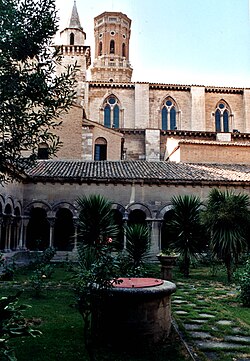This article needs additional citations for verification .(May 2017) |
| Tudela Cathedral | |
|---|---|
| Co-Cathedral of Saint Mary of Tudela | |
Spanish: Catedral de Tudela | |
 The cathedral viewed from the cloister | |
| Country | Spain |
| Denomination | Roman Catholic Church |
| Architecture | |
| Functional status | Active |
| Heritage designation | Monumento |
| Designated | 1884 |
| Architectural type | church |
| Style | Romanesque, Gothic |
| Administration | |
| Archdiocese | Roman Catholic Archdiocese of Pamplona and Tudela |
The Cathedral of Saint Mary of Tudela (Spanish: Catedral de Santa Maria) is a Roman Catholic cathedral located in Plaza Vieja in the center of Tudela, autonomous community of Navarre, Spain. The medieval building was originally a collegiate church. It became a cathedral with the creation of the Diocese of Tudela, which existed 1783-1851 and again 1889-1956. It is now a co-cathedral in the Archdiocese of Pamplona and Tudela.


